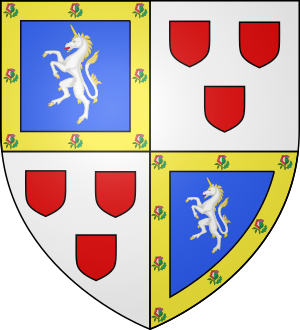George Hay, 8th Earl of Kinnoull facts for kids
Quick facts for kids
The Earl of Kinnoull
|
|
|---|---|

Coat of arms of the Earls of Kinnoull
|
|
| Member of Parliament for Fowey | |
| In office 1710–1711 |
|
| Teller of the Exchequer | |
| In office 1711–1715 |
|
| Preceded by | Peregrine Bertie |
| Succeeded by | Sir Roger Mostyn, Bt |
| Personal details | |
| Born | 23 June 1689 |
| Died | 28 July 1758 (aged 69) Ashford, Surrey |
| Political party | Conservative |
| Spouse |
Abigail Harley
(m. 1709) |
| Children | 10, including Thomas and Robert |
| Parents |
|
George Henry Hay, 8th Earl of Kinnoull (born June 23, 1689 – died July 28, 1758) was an important British nobleman and diplomat. He was also a Fellow of the Royal Society, which means he was recognized for his contributions to science. From 1709 to 1719, people knew him as Viscount Dupplin.
George was the oldest son of Thomas Hay, 7th Earl of Kinnoull and Elizabeth Drummond. His family was well-known in Scotland.
Contents
Early Life and Political Connections
In 1708, George became close to Robert Harley, 1st Earl of Oxford and Earl Mortimer. Robert Harley was a very powerful politician, similar to a prime minister today. George married Harley's daughter, Abigail, in 1709. This marriage helped George a lot in his career. He was also part of a group of politicians called the "October Club".
Joining Parliament
In 1710, George Hay became a Member of Parliament (MP) for Fowey. He served in this role until 1711. An MP is someone elected to represent people in the British Parliament.
Becoming a Baron
In 1711, George was given the title of Baron Hay of Pedwardine. He was one of twelve new barons created at that time. This group was known as Harley's Dozen. They were made barons to help the Tory government pass a peace treaty in the House of Lords. The House of Lords was usually controlled by another political group called the Whigs.
Working for the Government
After this, George became the Teller of the Exchequer from 1711 to 1714. This job involved managing the government's money. A politician named William Bromley once said that George was "so pretty a gentleman, so generally well beloved."
Life and Challenges
In March 1712, George was chosen as a Fellow of the Royal Society. This is a special honor for people who have made important discoveries or contributions to science. In 1713, he bought a large house called Brodsworth Hall in Yorkshire and rebuilt it.
Facing Accusations
During a time of unrest in 1715, George was suspected of supporting a rebellion called the Jacobite rising of 1715. He was held in the Tower of London for several months. Later, in 1722, he faced accusations of being involved in another plot, the Atterbury Plot. However, the House of Lords voted against investigating him further, and he was cleared.
Financial Troubles
In 1720, George lost a lot of money in a big financial crash known as the South Sea Bubble. This was a time when many people invested in a company that promised huge profits, but it ended up failing.
Diplomatic Role
On May 16, 1729, George was appointed the British ambassador to the Ottoman Empire. This meant he represented Britain in Turkey. He arrived in Constantinople (now Istanbul) in April 1730. He served there until he was called back in August 1735, leaving Turkey in the autumn of 1736.
Later Life and Family
George Henry Hay died in Ashford, Surrey, on July 28, 1758.
Marriage and Children
He married Abigail Harley around September 1, 1709. They had ten children together: four sons and six daughters.
- Thomas Hay, 9th Earl of Kinnoull
- Robert Hay Drummond, who became the Archbishop of York. He took on the name Drummond from his great-grandfather.
- John Hay (1719–1751), who was a rector (a type of priest) at Epworth.
- Edward, who was also a British diplomat and later the Governor of Barbados.
- Lady Margaret, who never married.
- Lady Elizabeth, who never married and died in Edinburgh in 1791.
- Lady Anne, who never married.
- Lady Abigail, who never married and died in London in 1785.
- Lady Henrietta, who married Robert Roper in 1754. She died in Oxford in 1798 without having children.
- Lady Mary, who married Bishop John Hume in 1758. He was a bishop in Oxford and Salisbury. She died in 1805.

